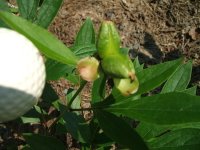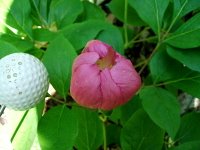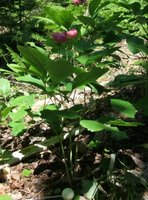 A woodland peony from Siberia, this species has ridiculously thin stems, and yet they are strong enough to stay upright all winter here, despite wet snow that levels most other peony stems. The relatively small flowers of the seedlots I've grown remain globular, the one in the photo is as open as they get (until the petals fall off).
A woodland peony from Siberia, this species has ridiculously thin stems, and yet they are strong enough to stay upright all winter here, despite wet snow that levels most other peony stems. The relatively small flowers of the seedlots I've grown remain globular, the one in the photo is as open as they get (until the petals fall off). Here is a group in the display bed.
Here is a group in the display bed. One of my plants in the woods had the crown of the root exposed by erosion last winter. In spring it looked like it had had the biscuit, but eventually a single stalk emerged from it. I've since covered it over with more soil and mulch. (photo from 6 May)
One of my plants in the woods had the crown of the root exposed by erosion last winter. In spring it looked like it had had the biscuit, but eventually a single stalk emerged from it. I've since covered it over with more soil and mulch. (photo from 6 May)I was also surprised earlier this year by the flowering of two plants of Paeonia obovata var. alba which were growing in 1-gallon pots (that's supposed to be a transition size for one year only but the transplanting "schedule" went all awry the past few years and a lot of plants are still languishing in the small pots). Due to their location in
 pot farms they warmed and developed earlier than the plants in the display bed, blooming a few weeks ago. To avoid confusion I decided not to post the photos until the rest of obovata were in flower.
pot farms they warmed and developed earlier than the plants in the display bed, blooming a few weeks ago. To avoid confusion I decided not to post the photos until the rest of obovata were in flower. The flowers are from different seed sources (both are from plants in cultivation, the first from a seed exchange, the second one generation removed from a wild collection); note the difference in the colour of the stamens in the second one. Flowers in both of these are larger and open more widely (almost flat) than the rest of the obovata I've grown.
The flowers are from different seed sources (both are from plants in cultivation, the first from a seed exchange, the second one generation removed from a wild collection); note the difference in the colour of the stamens in the second one. Flowers in both of these are larger and open more widely (almost flat) than the rest of the obovata I've grown.
















 Carpels of Paeonia anomala subsp intermedia
Carpels of Paeonia anomala subsp intermedia





